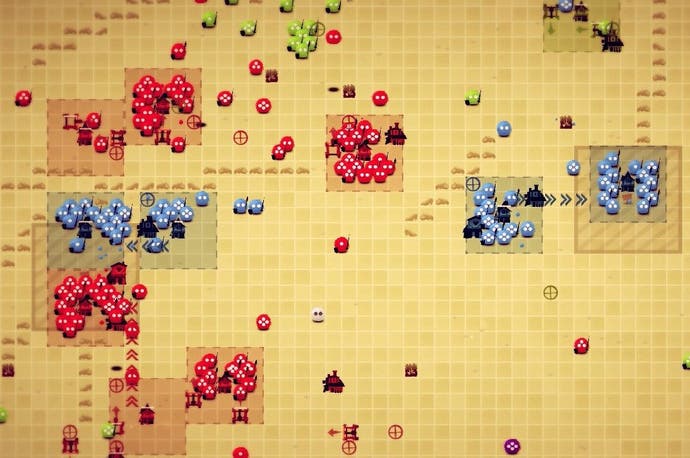Automata Empires: An RTS based on Conway's Game of Life
Ready player zero.
Beehives, honey farms, spaceships, powder kegs. Beacons, toads, pinwheels, crosses. These are all elements of a strange game that tore a path through the hacking community in the early 1970s: LIFE, also known as Conway's Game of Life. John Conway is a British mathematician, and Life is a cellular automata - a spreadsheet, in essence, in which cells populate and depopulate depending on criteria such as the state of the cells that surround them. Time passes, shapes emerge through simple interactions. It all starts to look rather organic. It's been called a zero-player game.
Conway's Game of Life is fascinating to mess around with. You plug in a starting shape and see what happens. Most often, your shape shifts and warps and inverts a few times and then starts to decay: most dribble away to nothing after a few generations. For years, according to the brilliant write-up in Steven Levy's Hackers, the holy grail of Lifers was something called a "glider gun". This was a starting formation that would create gliders, or patterns that "would move across the screen, periodically reverting to the same shape." Conway offered $50 to the inventor - or discoverer? - of the first glider gun, but even without that incentive people needed little encouragement to spend their time rooting around in Life. Some sort of fell into it and spent decades sounding out its depths, only to emerge, blinking, into a world that no longer valued tie-dyes quite so highly. Some never emerged at all.
All of which, I think, makes the case that the zero-player game was never really a zero-player game. Now it definitely isn't, anyway. Automata Empire popped up on Steam the other day, and it turns Conway's Game of Life into a sort of RTS in which you, well, do what you generally do in an RTS: build your forces and crush the enemy. You try to, anyway. Life often intervenes.
Automata Empire is wonderful stuff: a game that's all about creating feedback loops as you try to turn a handful of automata into a gaggle, a gang, an overwhelming force. You do this by intermingling them, since packs of monsters that meet on the field will double their numbers, splitting off into separate packs when they reach a critical mass. By and large, over the course of my first few skirmishes, I have had no trouble building up my troops. The problem comes when I try to get them to attack the enemy. Despite the objects I can place to guide them, I'm dealing with something that feels a lot like organic life here. It doesn't always do what I want it to do.
Deep down, the game revolves around understanding the simple rules that govern the behaviour of your automata - the simple rules that come together to create complex outcomes. Monster packs of different sizes move in different ways, for starters, and then there are buildings: walls and roads, taverns that attract packs, arsenals that give them weapons, catapults that fling them across the map. I'm starting to get my head around some of this stuff, but it would still be weird to watch one of my battles, I suspect. It's like an anti-battle. An unbattle. Both sides are present and seem to want to get at it, but they steadfastly refuse to connect cleanly with the enemy.
I love this, I think. I've been a fan of Conway's Game of Life ever since I first read Levy's book, and it's so interesting to see how little of a nudge it needs to be transformed into something like Automata Empire - and how much it in turn brings to a genre that I thought I understood. There's something powerfully skin-crawly about it: these little guys, swarming and multiplying with no idea of what set them in motion. It's not quite life, but it's certainly Life, and I'm going to keep plugging away until I can turn my very own glider gun on my enemies.


